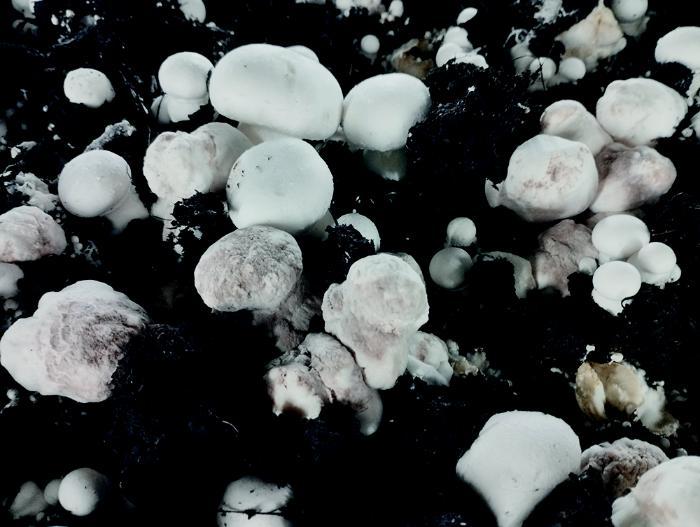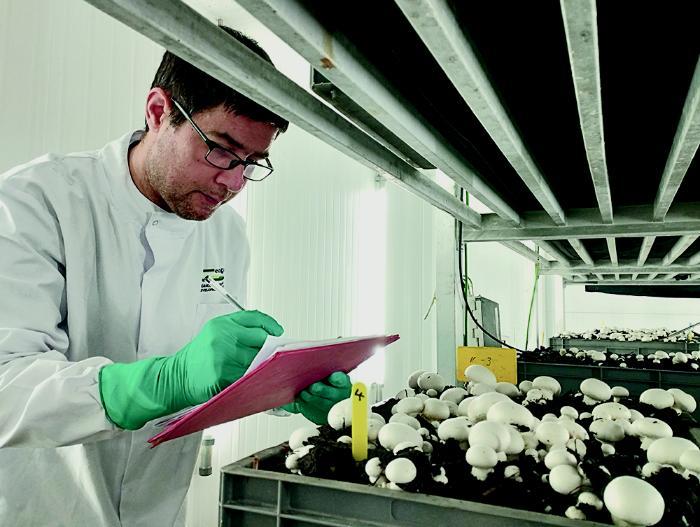21 February 2025
Going viral
Research at the Horticulture Development Department at Teagasc Ashtown is exploring the potential use of viruses to combat pathogens in commercial mushroom cultivation.

Typical symptoms of dry bubble disease on a mushroom crop. Credit: Teagasc
Mushroom cultivation is a significant horticultural enterprise in many countries. In Ireland, commercial mushroom production is the largest horticultural sector, accounting for around 26% of total production. There are various factors that can substantially reduce mushroom yield, including dry bubble disease, which must be controlled to prevent economic loss. However, as the number of chemical pesticides approved for use dwindles, more attention is given to investigating novel, alternative methods for effective pest management.
Viruses are widespread in nature and are associated with all groups of living creatures such as bacteria, fungi (including mushrooms), plants, animals and humans. Contrary to general perception, most viruses are benign, with no apparent impact on their host organisms. Interestingly, some even provide their hosts with beneficial features, such as drought or cold tolerance conferred by plant viruses in crops such as rice, cucumber, tomato and beetroot. Nevertheless, others can cause severe, even fatal, diseases.
Combatting pathogens
Lorant Hatvani is a research fellow at Teagasc Ashtown’s Food Research Centre. He received a Research Leaders 2025 Fellowship for his project, Leca-VIR, which examined the potential role of viruses in the development of dry bubble disease of mushrooms caused by the fungus Lecanicillium fungicola.
Mycoviruses are viruses that infect fungi and most of them are symptomless, causing no obvious macroscopic alterations in their hosts, Lorant explains.
“However, of great interest to the crop protection research community, several mycoviruses have been found to significantly affect various plant pathogenic fungi, with some viruses reducing the ability of pathogens to cause disease – what’s known as hypovirulence.”
A mycovirus causing hypovirulence in the plant pathogenic fungus Cryphonetctria parasitica was successfully applied in the field, where it naturally disseminated and controlled blight disease of sweet chestnut trees. Further promising mycoviruses with potential biological control activity have since been discovered.
The objectives of Lorant’s Leca-VIR project were twofold: examine fungal viruses in the causal agents of dry bubble disease, and investigate the possibility that some viruses might be of interest for biological disease control in mushroom cultivation. The work was done in collaboration with the fungal virology group at the Institute of Plant Science and Resources (IPSR), Okayama University (Japan) and the Genome Evolution Laboratory at Maynooth University, with the purpose of knowledge transfer between the participants.
“Several mycoviruses have been found to significantly affect various plant pathogenic fungi, with some viruses reducing the ability of pathogens to cause disease.”

Lorant Hatvani examining mushroom crop trials at Teagasc Food Research Centre, Ashtown. Credit: Teagasc
Identifying viruses
During the Outgoing Phase of the project spent at IPSR, the researchers examined a collection of 57 fungal cultures, obtained from dry-bubble-affected mushroom crops in several countries, Lorant explains.
“Virus screening by cellulose column chromatography revealed the presence of ten putative viral elements, which were subsequently identified by next-generation sequencing. A further three mycoviruses were also found during the identification process, which resulted in the discovery of potential novel species.”
To examine the potential impact of these viruses on their hosts, they were eliminated from the fungal cultures (virus-curing) using different techniques such as cultivation under adverse conditions (nutrient limitation and drought stress) or by the application of different antiviral drugs. Comparison of the growth and spore production of the original, virus-containing cultures and their virus-cured counterparts revealed virus-cured cultures with substantially increased spore production (2-5x) following the removal of a partitivirus.
“No remarkable differences were observed in any other cultures,” Lorant notes. “This finding suggests that the partitivirus may negatively affect the production of spores, which are essential for the spreading of dry bubble disease. Therefore, it may be a potential tool for biological disease control.”
The virus was successfully introduced into two originally virus-free L. fungicola isolates obtained from industry, by allowing them to interact and fuse with the virus-carrying “donor” culture.
Promising results
The Return Phase of the project was undertaken in the Mushroom Research Unit at Teagasc Ashtown. Using partitivirus-carrying cultures and their virus-cured derivatives, the researchers examined the potential impact of the discovered partitivirus on dry bubble disease development in mushroom crops.
Lorant explains: “In crop trials, less disease occurred following infection with the virus-containing pathogen, while significantly increased symptom development was observed when the virus was absent. This confirmed the hypothesised negative effect of the virus on the performance of the pathogenic fungus.”
In proteomic studies performed in collaboration with Maynooth University, proteins associated with the production of membrane components were detected in higher abundance in the virus-cured culture, compared to the virus-containing culture, suggesting that the partitivirus might have a negative effect on cell membrane integrity and function.
“Unfortunately, according to the results of additional crop trials, the experimental introduction of the partitivirus into two originally virus-free fungal cultures did not lead to reduced virulence of the pathogen,” Lorant notes.
“This suggests that the observed negative effects attributed to this virus may be strain-specific, rather than universal. Although the partitivirus examined in this study does not seem to provide a solution for the control of dry bubble disease, the findings of the Leca-VIR project have contributed to the discovery of potential new viral species as well as to our understanding of the biological role of viruses in fungal pathogens that affect the production of agricultural crops.”
Funding
Lorant Hatvani has received funding from the Research Leaders 2025 programme co-funded by Teagasc and the European Union’s Horizon 2020 research and innovation programme under the Marie Skłodowska-Curie grant agreement number 754380.
Acknowledgements
The authors greatly acknowledge valuable contributions of Brian McGuinness and Antonia Santos (Teagasc); Hideki Kondo, Sakae Hisano, Paul Telengech, Savitri Shahi, Sarah Ibiang and Kazuyuki Maruyama (Okayama University); and Kevin Kavanagh, Joy Clarke and Aaron Curtis (Maynooth University).
Contributors
Lorant Hatvani, Research Leaders 2025 Fellow, Horticulture Development Department, Teagasc Ashtown.
Nobuhiro Suzuki, Full Professor IPSR, Okayama University, Japan.
David Fitzpatrick, Associate Professor Department of Biology, Maynooth University.
Helen Grogan, Senior Research Officer, Horticulture Development Department, Teagasc Ashtown. helen.grogan@teagasc.ie
